Analyzing Methodological Approaches in Education Research Paradigms
VerifiedAdded on 2023/06/13
|6
|1557
|352
Essay
AI Summary
This essay delves into methodological approaches within education research, emphasizing the significance of research paradigms—qualitative, quantitative, and mixed methods. It discusses how these paradigms influence research strategies and the interpretation of reality. Quantitative research is characterized by testing interrelations and deductive reasoning, while qualitative research employs inductive reasoning to identify patterns and infer generalizations. Mixed methods research combines these approaches to provide comprehensive answers to complex educational questions. The essay also explores the strengths and limitations of using NVivo for qualitative data analysis, highlighting its utility in organizing, managing, and analyzing various forms of data, while also acknowledging its inability to perform analytical thinking independently. It emphasizes NVivo's role in team-based research, facilitating consistency and collaboration among researchers. Despite its limitations, NVivo enhances the efficiency and integration of research projects, making it a valuable tool for educational research.
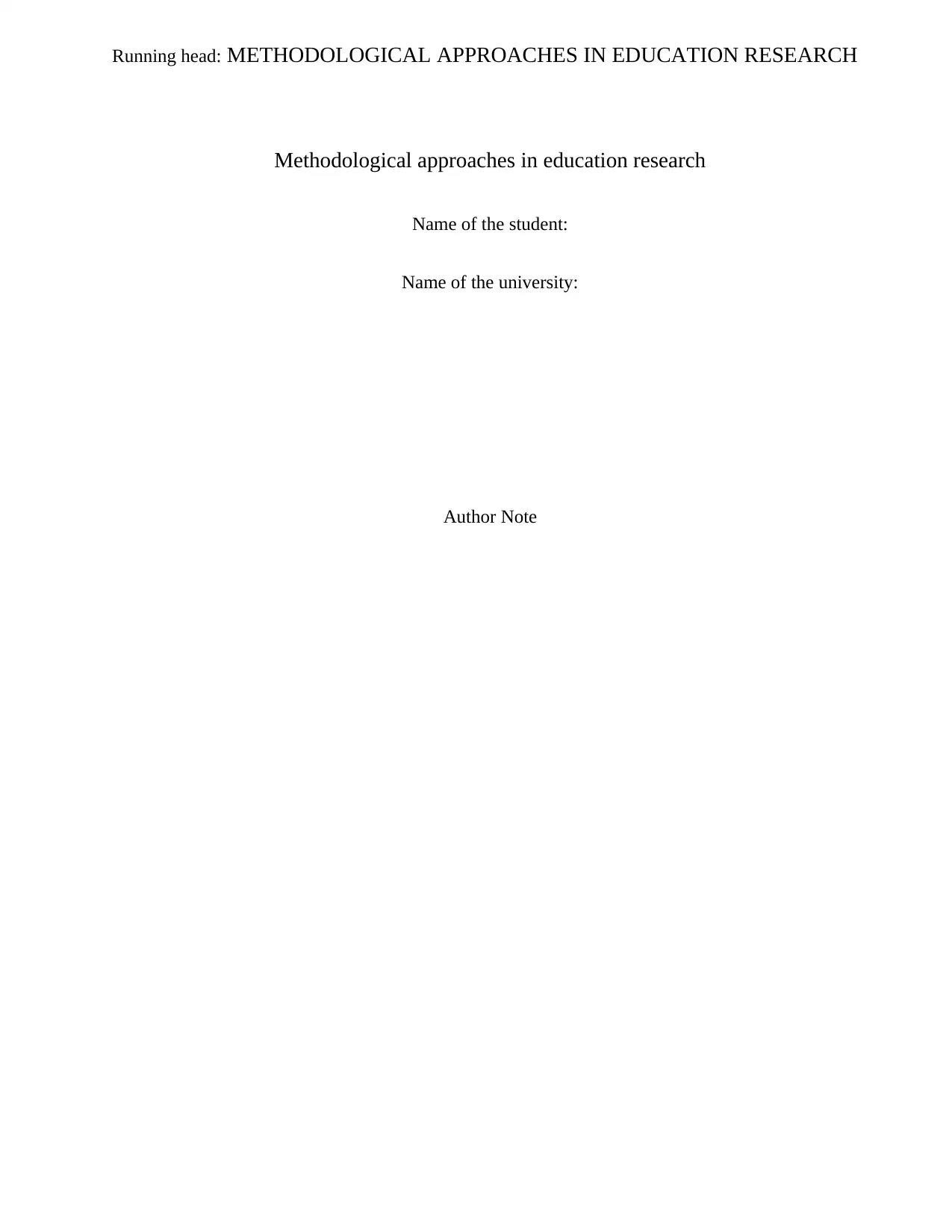
Running head: METHODOLOGICAL APPROACHES IN EDUCATION RESEARCH
Methodological approaches in education research
Name of the student:
Name of the university:
Author Note
Methodological approaches in education research
Name of the student:
Name of the university:
Author Note
Paraphrase This Document
Need a fresh take? Get an instant paraphrase of this document with our AI Paraphraser
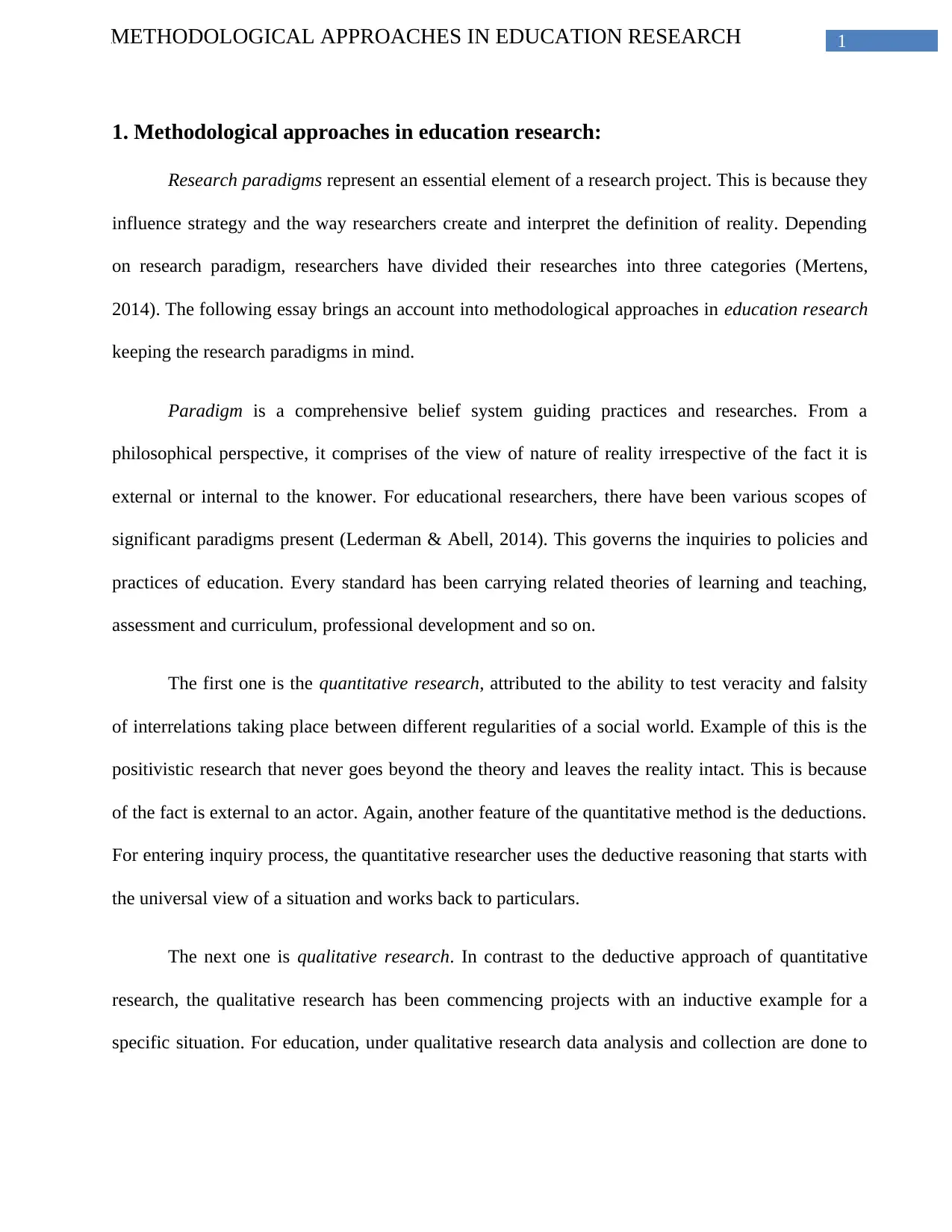
1METHODOLOGICAL APPROACHES IN EDUCATION RESEARCH
1. Methodological approaches in education research:
Research paradigms represent an essential element of a research project. This is because they
influence strategy and the way researchers create and interpret the definition of reality. Depending
on research paradigm, researchers have divided their researches into three categories (Mertens,
2014). The following essay brings an account into methodological approaches in education research
keeping the research paradigms in mind.
Paradigm is a comprehensive belief system guiding practices and researches. From a
philosophical perspective, it comprises of the view of nature of reality irrespective of the fact it is
external or internal to the knower. For educational researchers, there have been various scopes of
significant paradigms present (Lederman & Abell, 2014). This governs the inquiries to policies and
practices of education. Every standard has been carrying related theories of learning and teaching,
assessment and curriculum, professional development and so on.
The first one is the quantitative research, attributed to the ability to test veracity and falsity
of interrelations taking place between different regularities of a social world. Example of this is the
positivistic research that never goes beyond the theory and leaves the reality intact. This is because
of the fact is external to an actor. Again, another feature of the quantitative method is the deductions.
For entering inquiry process, the quantitative researcher uses the deductive reasoning that starts with
the universal view of a situation and works back to particulars.
The next one is qualitative research. In contrast to the deductive approach of quantitative
research, the qualitative research has been commencing projects with an inductive example for a
specific situation. For education, under qualitative research data analysis and collection are done to
1. Methodological approaches in education research:
Research paradigms represent an essential element of a research project. This is because they
influence strategy and the way researchers create and interpret the definition of reality. Depending
on research paradigm, researchers have divided their researches into three categories (Mertens,
2014). The following essay brings an account into methodological approaches in education research
keeping the research paradigms in mind.
Paradigm is a comprehensive belief system guiding practices and researches. From a
philosophical perspective, it comprises of the view of nature of reality irrespective of the fact it is
external or internal to the knower. For educational researchers, there have been various scopes of
significant paradigms present (Lederman & Abell, 2014). This governs the inquiries to policies and
practices of education. Every standard has been carrying related theories of learning and teaching,
assessment and curriculum, professional development and so on.
The first one is the quantitative research, attributed to the ability to test veracity and falsity
of interrelations taking place between different regularities of a social world. Example of this is the
positivistic research that never goes beyond the theory and leaves the reality intact. This is because
of the fact is external to an actor. Again, another feature of the quantitative method is the deductions.
For entering inquiry process, the quantitative researcher uses the deductive reasoning that starts with
the universal view of a situation and works back to particulars.
The next one is qualitative research. In contrast to the deductive approach of quantitative
research, the qualitative research has been commencing projects with an inductive example for a
specific situation. For education, under qualitative research data analysis and collection are done to
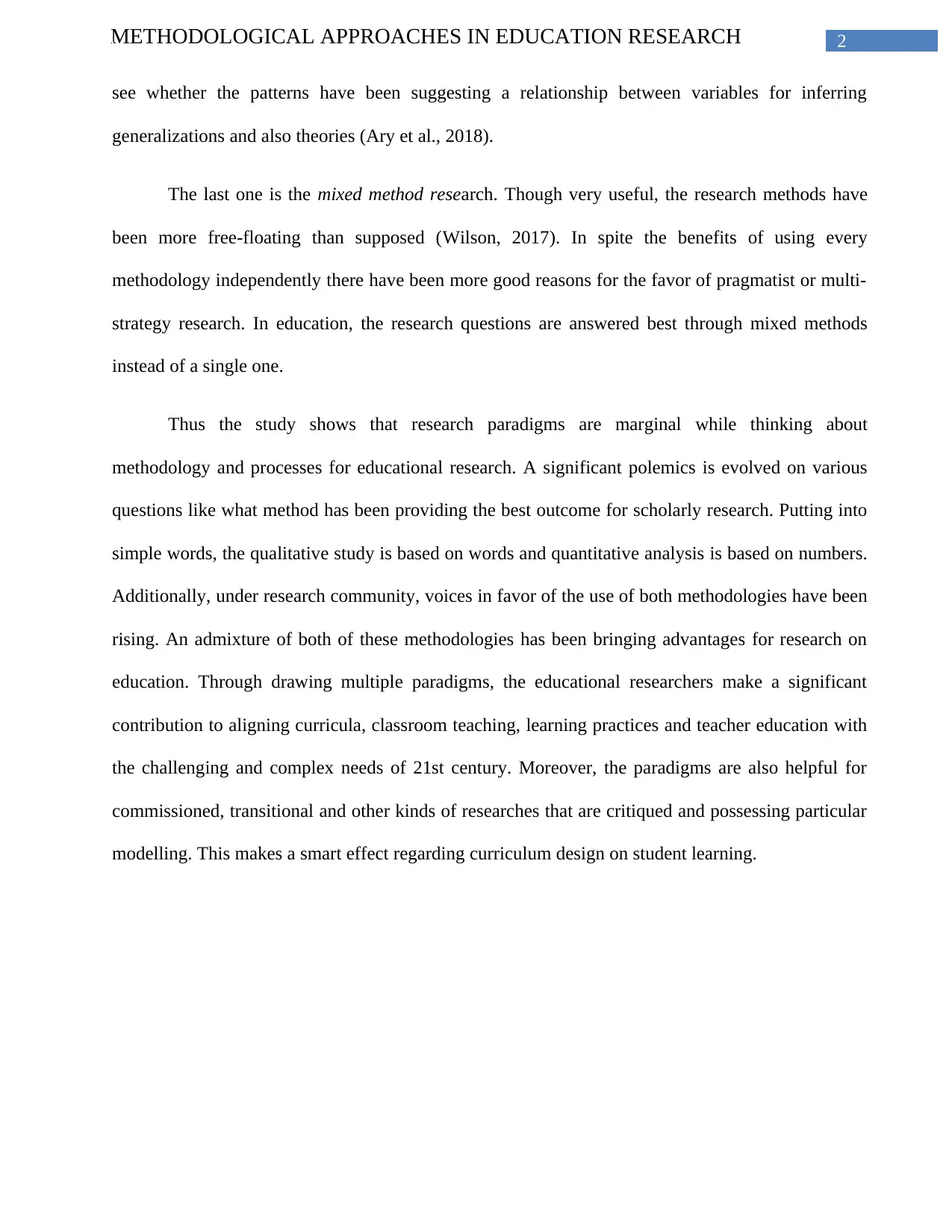
2METHODOLOGICAL APPROACHES IN EDUCATION RESEARCH
see whether the patterns have been suggesting a relationship between variables for inferring
generalizations and also theories (Ary et al., 2018).
The last one is the mixed method research. Though very useful, the research methods have
been more free-floating than supposed (Wilson, 2017). In spite the benefits of using every
methodology independently there have been more good reasons for the favor of pragmatist or multi-
strategy research. In education, the research questions are answered best through mixed methods
instead of a single one.
Thus the study shows that research paradigms are marginal while thinking about
methodology and processes for educational research. A significant polemics is evolved on various
questions like what method has been providing the best outcome for scholarly research. Putting into
simple words, the qualitative study is based on words and quantitative analysis is based on numbers.
Additionally, under research community, voices in favor of the use of both methodologies have been
rising. An admixture of both of these methodologies has been bringing advantages for research on
education. Through drawing multiple paradigms, the educational researchers make a significant
contribution to aligning curricula, classroom teaching, learning practices and teacher education with
the challenging and complex needs of 21st century. Moreover, the paradigms are also helpful for
commissioned, transitional and other kinds of researches that are critiqued and possessing particular
modelling. This makes a smart effect regarding curriculum design on student learning.
see whether the patterns have been suggesting a relationship between variables for inferring
generalizations and also theories (Ary et al., 2018).
The last one is the mixed method research. Though very useful, the research methods have
been more free-floating than supposed (Wilson, 2017). In spite the benefits of using every
methodology independently there have been more good reasons for the favor of pragmatist or multi-
strategy research. In education, the research questions are answered best through mixed methods
instead of a single one.
Thus the study shows that research paradigms are marginal while thinking about
methodology and processes for educational research. A significant polemics is evolved on various
questions like what method has been providing the best outcome for scholarly research. Putting into
simple words, the qualitative study is based on words and quantitative analysis is based on numbers.
Additionally, under research community, voices in favor of the use of both methodologies have been
rising. An admixture of both of these methodologies has been bringing advantages for research on
education. Through drawing multiple paradigms, the educational researchers make a significant
contribution to aligning curricula, classroom teaching, learning practices and teacher education with
the challenging and complex needs of 21st century. Moreover, the paradigms are also helpful for
commissioned, transitional and other kinds of researches that are critiqued and possessing particular
modelling. This makes a smart effect regarding curriculum design on student learning.
⊘ This is a preview!⊘
Do you want full access?
Subscribe today to unlock all pages.

Trusted by 1+ million students worldwide
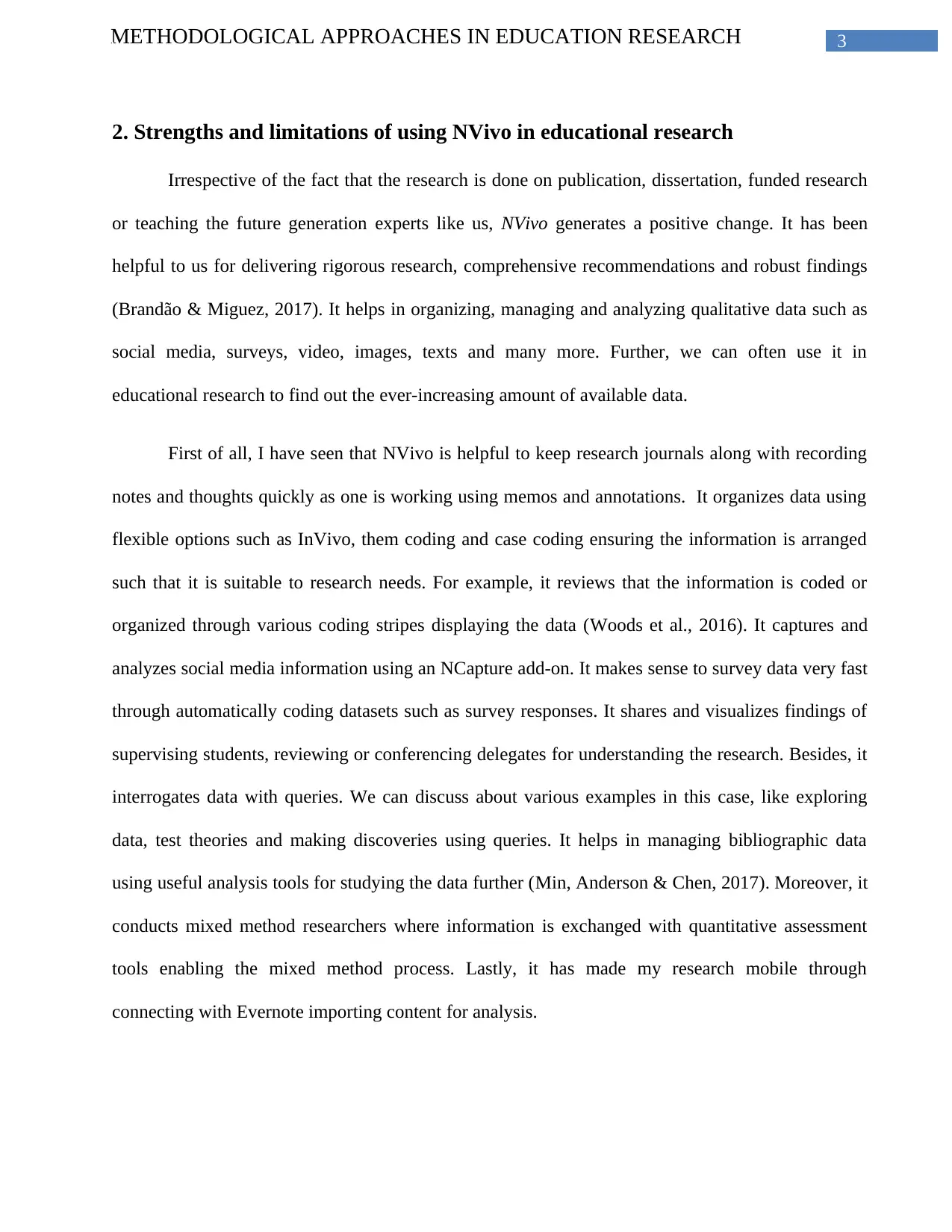
3METHODOLOGICAL APPROACHES IN EDUCATION RESEARCH
2. Strengths and limitations of using NVivo in educational research
Irrespective of the fact that the research is done on publication, dissertation, funded research
or teaching the future generation experts like us, NVivo generates a positive change. It has been
helpful to us for delivering rigorous research, comprehensive recommendations and robust findings
(Brandão & Miguez, 2017). It helps in organizing, managing and analyzing qualitative data such as
social media, surveys, video, images, texts and many more. Further, we can often use it in
educational research to find out the ever-increasing amount of available data.
First of all, I have seen that NVivo is helpful to keep research journals along with recording
notes and thoughts quickly as one is working using memos and annotations. It organizes data using
flexible options such as InVivo, them coding and case coding ensuring the information is arranged
such that it is suitable to research needs. For example, it reviews that the information is coded or
organized through various coding stripes displaying the data (Woods et al., 2016). It captures and
analyzes social media information using an NCapture add-on. It makes sense to survey data very fast
through automatically coding datasets such as survey responses. It shares and visualizes findings of
supervising students, reviewing or conferencing delegates for understanding the research. Besides, it
interrogates data with queries. We can discuss about various examples in this case, like exploring
data, test theories and making discoveries using queries. It helps in managing bibliographic data
using useful analysis tools for studying the data further (Min, Anderson & Chen, 2017). Moreover, it
conducts mixed method researchers where information is exchanged with quantitative assessment
tools enabling the mixed method process. Lastly, it has made my research mobile through
connecting with Evernote importing content for analysis.
2. Strengths and limitations of using NVivo in educational research
Irrespective of the fact that the research is done on publication, dissertation, funded research
or teaching the future generation experts like us, NVivo generates a positive change. It has been
helpful to us for delivering rigorous research, comprehensive recommendations and robust findings
(Brandão & Miguez, 2017). It helps in organizing, managing and analyzing qualitative data such as
social media, surveys, video, images, texts and many more. Further, we can often use it in
educational research to find out the ever-increasing amount of available data.
First of all, I have seen that NVivo is helpful to keep research journals along with recording
notes and thoughts quickly as one is working using memos and annotations. It organizes data using
flexible options such as InVivo, them coding and case coding ensuring the information is arranged
such that it is suitable to research needs. For example, it reviews that the information is coded or
organized through various coding stripes displaying the data (Woods et al., 2016). It captures and
analyzes social media information using an NCapture add-on. It makes sense to survey data very fast
through automatically coding datasets such as survey responses. It shares and visualizes findings of
supervising students, reviewing or conferencing delegates for understanding the research. Besides, it
interrogates data with queries. We can discuss about various examples in this case, like exploring
data, test theories and making discoveries using queries. It helps in managing bibliographic data
using useful analysis tools for studying the data further (Min, Anderson & Chen, 2017). Moreover, it
conducts mixed method researchers where information is exchanged with quantitative assessment
tools enabling the mixed method process. Lastly, it has made my research mobile through
connecting with Evernote importing content for analysis.
Paraphrase This Document
Need a fresh take? Get an instant paraphrase of this document with our AI Paraphraser
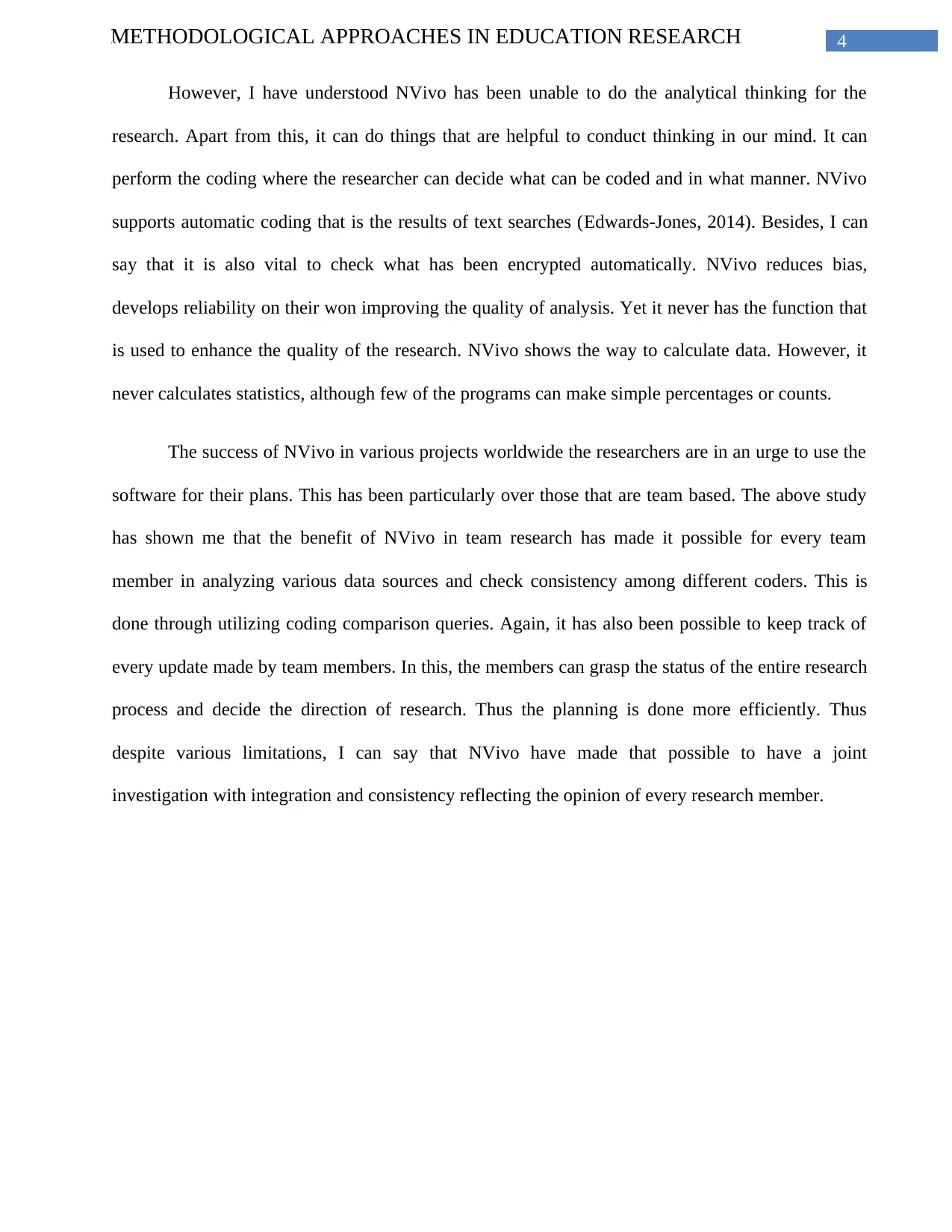
4METHODOLOGICAL APPROACHES IN EDUCATION RESEARCH
However, I have understood NVivo has been unable to do the analytical thinking for the
research. Apart from this, it can do things that are helpful to conduct thinking in our mind. It can
perform the coding where the researcher can decide what can be coded and in what manner. NVivo
supports automatic coding that is the results of text searches (Edwards-Jones, 2014). Besides, I can
say that it is also vital to check what has been encrypted automatically. NVivo reduces bias,
develops reliability on their won improving the quality of analysis. Yet it never has the function that
is used to enhance the quality of the research. NVivo shows the way to calculate data. However, it
never calculates statistics, although few of the programs can make simple percentages or counts.
The success of NVivo in various projects worldwide the researchers are in an urge to use the
software for their plans. This has been particularly over those that are team based. The above study
has shown me that the benefit of NVivo in team research has made it possible for every team
member in analyzing various data sources and check consistency among different coders. This is
done through utilizing coding comparison queries. Again, it has also been possible to keep track of
every update made by team members. In this, the members can grasp the status of the entire research
process and decide the direction of research. Thus the planning is done more efficiently. Thus
despite various limitations, I can say that NVivo have made that possible to have a joint
investigation with integration and consistency reflecting the opinion of every research member.
However, I have understood NVivo has been unable to do the analytical thinking for the
research. Apart from this, it can do things that are helpful to conduct thinking in our mind. It can
perform the coding where the researcher can decide what can be coded and in what manner. NVivo
supports automatic coding that is the results of text searches (Edwards-Jones, 2014). Besides, I can
say that it is also vital to check what has been encrypted automatically. NVivo reduces bias,
develops reliability on their won improving the quality of analysis. Yet it never has the function that
is used to enhance the quality of the research. NVivo shows the way to calculate data. However, it
never calculates statistics, although few of the programs can make simple percentages or counts.
The success of NVivo in various projects worldwide the researchers are in an urge to use the
software for their plans. This has been particularly over those that are team based. The above study
has shown me that the benefit of NVivo in team research has made it possible for every team
member in analyzing various data sources and check consistency among different coders. This is
done through utilizing coding comparison queries. Again, it has also been possible to keep track of
every update made by team members. In this, the members can grasp the status of the entire research
process and decide the direction of research. Thus the planning is done more efficiently. Thus
despite various limitations, I can say that NVivo have made that possible to have a joint
investigation with integration and consistency reflecting the opinion of every research member.
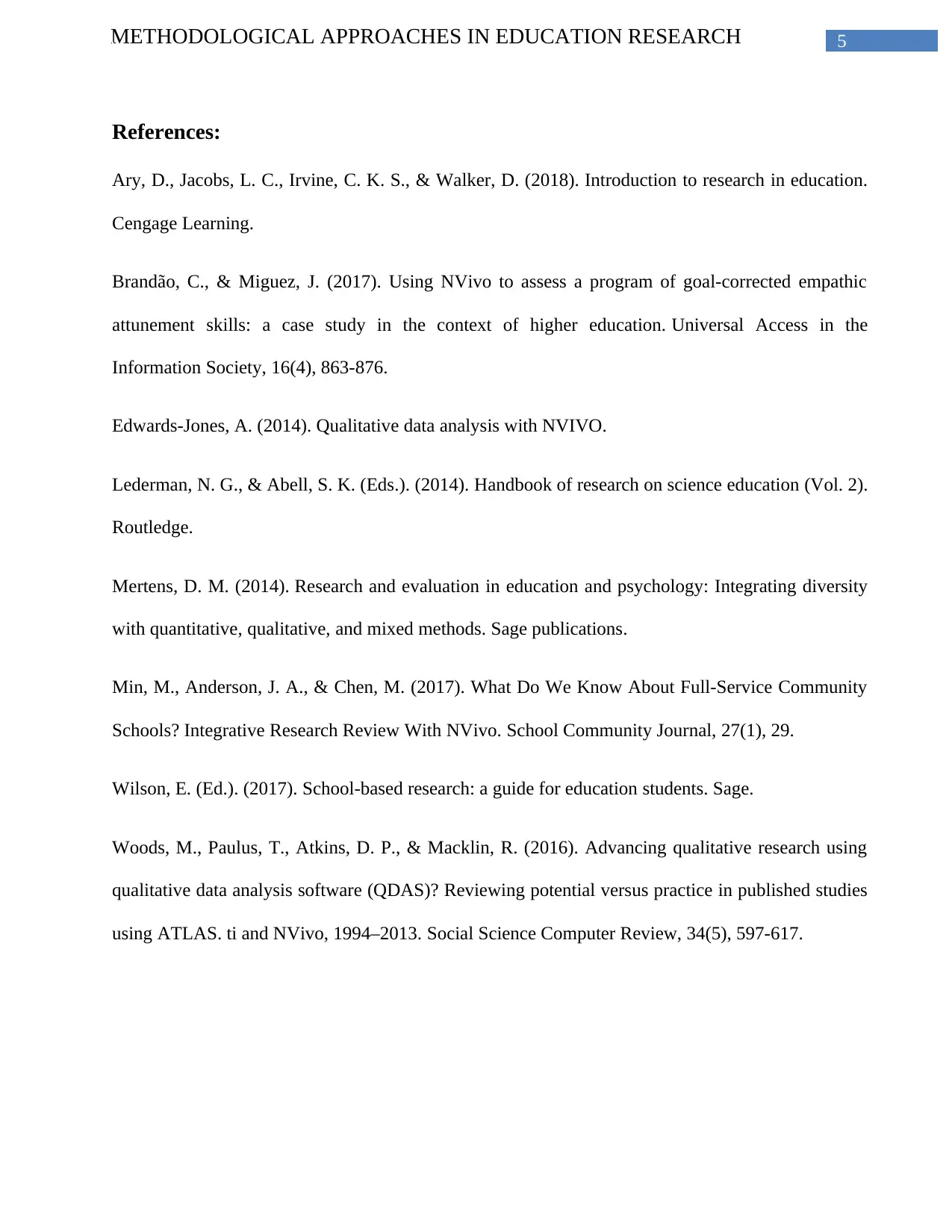
5METHODOLOGICAL APPROACHES IN EDUCATION RESEARCH
References:
Ary, D., Jacobs, L. C., Irvine, C. K. S., & Walker, D. (2018). Introduction to research in education.
Cengage Learning.
Brandão, C., & Miguez, J. (2017). Using NVivo to assess a program of goal-corrected empathic
attunement skills: a case study in the context of higher education. Universal Access in the
Information Society, 16(4), 863-876.
Edwards-Jones, A. (2014). Qualitative data analysis with NVIVO.
Lederman, N. G., & Abell, S. K. (Eds.). (2014). Handbook of research on science education (Vol. 2).
Routledge.
Mertens, D. M. (2014). Research and evaluation in education and psychology: Integrating diversity
with quantitative, qualitative, and mixed methods. Sage publications.
Min, M., Anderson, J. A., & Chen, M. (2017). What Do We Know About Full-Service Community
Schools? Integrative Research Review With NVivo. School Community Journal, 27(1), 29.
Wilson, E. (Ed.). (2017). School-based research: a guide for education students. Sage.
Woods, M., Paulus, T., Atkins, D. P., & Macklin, R. (2016). Advancing qualitative research using
qualitative data analysis software (QDAS)? Reviewing potential versus practice in published studies
using ATLAS. ti and NVivo, 1994–2013. Social Science Computer Review, 34(5), 597-617.
References:
Ary, D., Jacobs, L. C., Irvine, C. K. S., & Walker, D. (2018). Introduction to research in education.
Cengage Learning.
Brandão, C., & Miguez, J. (2017). Using NVivo to assess a program of goal-corrected empathic
attunement skills: a case study in the context of higher education. Universal Access in the
Information Society, 16(4), 863-876.
Edwards-Jones, A. (2014). Qualitative data analysis with NVIVO.
Lederman, N. G., & Abell, S. K. (Eds.). (2014). Handbook of research on science education (Vol. 2).
Routledge.
Mertens, D. M. (2014). Research and evaluation in education and psychology: Integrating diversity
with quantitative, qualitative, and mixed methods. Sage publications.
Min, M., Anderson, J. A., & Chen, M. (2017). What Do We Know About Full-Service Community
Schools? Integrative Research Review With NVivo. School Community Journal, 27(1), 29.
Wilson, E. (Ed.). (2017). School-based research: a guide for education students. Sage.
Woods, M., Paulus, T., Atkins, D. P., & Macklin, R. (2016). Advancing qualitative research using
qualitative data analysis software (QDAS)? Reviewing potential versus practice in published studies
using ATLAS. ti and NVivo, 1994–2013. Social Science Computer Review, 34(5), 597-617.
⊘ This is a preview!⊘
Do you want full access?
Subscribe today to unlock all pages.

Trusted by 1+ million students worldwide
1 out of 6
Related Documents
Your All-in-One AI-Powered Toolkit for Academic Success.
+13062052269
info@desklib.com
Available 24*7 on WhatsApp / Email
![[object Object]](/_next/static/media/star-bottom.7253800d.svg)
Unlock your academic potential
Copyright © 2020–2025 A2Z Services. All Rights Reserved. Developed and managed by ZUCOL.





